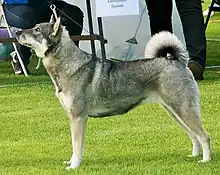| Jämthund | |||||||||||||||||||
|---|---|---|---|---|---|---|---|---|---|---|---|---|---|---|---|---|---|---|---|
 | |||||||||||||||||||
| Other names | Swedish Elkhound Jämptlanninpystykorva | ||||||||||||||||||
| Origin | Sweden | ||||||||||||||||||
| |||||||||||||||||||
| |||||||||||||||||||
| Dog (domestic dog) | |||||||||||||||||||
The Jämthund, also called the Swedish Elkhound, is a breed of dog of the Spitz type that is found in Northern Europe. The Jämthund is eponymous with Jämtland, a province in the middle of Sweden.
History
The Swedish Elkhound is one of a number of breeds of spitz-type hunting dogs that have been known throughout Scandinavia for centuries.[1][2] Historically these dogs have been used to hunt a wide variety of game including bear, elk, wolf and lynx.[1][3]
The Swedish Elkhound received official recognition as a breed in 1946, due to intensive work by Aksel Lindström and others. Before that, both it and the Norwegian Elkhound were seen as the same breed. They are both used for hunting large game, such as moose and bear.
Lineage
The breed falls under the mitochondrial DNA sub-clade referred to as d1 that is only found in northern Scandinavia. It is the result of a male dog-female wolf hybridization that occurred post-domestication.[4][5] Subclade d1 that is thought to have originated "no more than 480–3,000 years ago" and it includes all Sámi-related breeds: Finnish Lapphund, Swedish Lapphund, Lapponian Herder, Swedish Elkhound, Norwegian Elkhound, Black Norwegian Elkhound and Hällefors Elkhound. The maternal wolf sequence that contributed to these breeds has not been matched across Eurasia[6] and its branch on the phylogenetic tree is rooted in the same sequence as the 33,000 year-old Altai dog (not a direct ancestor).[7]
Description
Appearance
The dog should have a loosely curled tail that hangs on the back and is not too thin or too tightly curled; when relaxed the tail should hang straight down. This breed has erect ears with a wide space in between them, a medium to long muzzle, and a double coat of various shades of agouti. The eyes are brown. The size of the male is usually 57–65 centimetres (22–26 in), weighing 30–35 kilograms (66–77 lb). Females are usually between 52–60 centimetres (20–24 in), weighing 25–30 kilograms (55–66 lb).
The Swedish Elkhound should be distinguished from the Norwegian Elkhound. The Norwegian Elkhound is much shorter and stockier than the Swedish Elkhound, and its tail shape is very different. It also has a black mask on the muzzle, whereas the Swedish Elkhound has a white muzzle, white cheeks and typical wolf markings.
Temperament
Although calm and affectionate with its family, the Swedish Elkhound can be dominant with other dogs and has a strong prey drive. A truly all-around canine, it can go from a hunting trip and back to the family hearth with great aplomb. It takes things in stride and does not get ruffled easily, making it a steady partner in the field or at home.
The Swedish Elkhound is a happy learner who loves to please its owner.
See also
References
- 1 2 Fogle, Bruce (2009). The encyclopedia of the dog. New York: DK Publishing. p. 145. ISBN 978-0-7566-6004-8.
- ↑ Wilcox, Bonnie; Walkowicz, Chris (1995). Atlas of dog breeds of the world. Neptune City, N.J.: TFH Publications. pp. 355–357.
- ↑ Morris, Desmond (2001). Dogs: the ultimate dictionary of over 1,000 dog breeds. North Pomfret, VT: Trafalgar Square Publishing. p. 104. ISBN 1-57076-219-8.
- ↑ Pang, J.-F.; Kluetsch, C.; Zou, X.-J.; Zhang, A.-b.; Luo, L.-Y.; Angleby, H.; Ardalan, A.; Ekstrom, C.; Skollermo, A.; Lundeberg, J.; Matsumura, S.; Leitner, T.; Zhang, Y.-P.; Savolainen, P. (2009). "MtDNA Data Indicate a Single Origin for Dogs South of Yangtze River, Less Than 16,300 Years Ago, from Numerous Wolves". Molecular Biology and Evolution. 26 (12): 2849–64. doi:10.1093/molbev/msp195. PMC 2775109. PMID 19723671.
- ↑ Duleba, Anna; Skonieczna, Katarzyna; Bogdanowicz, Wiesław; Malyarchuk, Boris; Grzybowski, Tomasz (2015). "Complete mitochondrial genome database and standardized classification system for Canis lupus familiaris". Forensic Science International: Genetics. 19: 123–129. doi:10.1016/j.fsigen.2015.06.014. PMID 26218982.
- ↑ Klütsch, C.F.C.; Savolainen, Peter (2011). "Regional occurrence, high frequency, but low diversity of mitochondrial dna haplogroup d1 suggests a recent dog-wolf hybridization in scandinavia". Journal of Veterinary Behavior: Clinical Applications and Research. 6 (1): 100–103. doi:10.1016/j.jveb.2010.08.035. PMC 3040290. PMID 20497152.
- ↑ Thalmann, O.; Shapiro, B.; Cui, P.; Schuenemann, V. J.; Sawyer, S. K.; Greenfield, D. L.; Germonpre, M. B.; Sablin, M. V.; Lopez-Giraldez, F.; Domingo-Roura, X.; Napierala, H.; Uerpmann, H.-P.; Loponte, D. M.; Acosta, A. A.; Giemsch, L.; Schmitz, R. W.; Worthington, B.; Buikstra, J. E.; Druzhkova, A.; Graphodatsky, A. S.; Ovodov, N. D.; Wahlberg, N.; Freedman, A. H.; Schweizer, R. M.; Koepfli, K.- P.; Leonard, J. A.; Meyer, M.; Krause, J.; Paabo, S.; Green, R. E. (2013). "Complete Mitochondrial Genomes of Ancient Canids Suggest a European Origin of Domestic Dogs". Science. 342 (6160): 871–4. Bibcode:2013Sci...342..871T. doi:10.1126/science.1243650. hdl:10261/88173. PMID 24233726. S2CID 1526260.
External links
 Media related to Jämthund at Wikimedia Commons
Media related to Jämthund at Wikimedia Commons